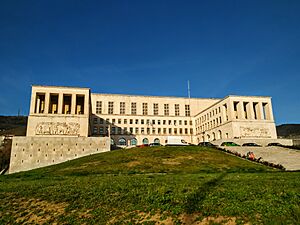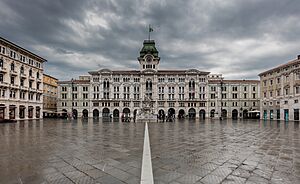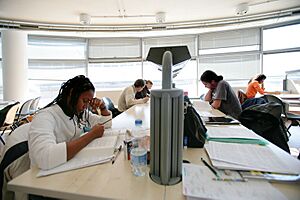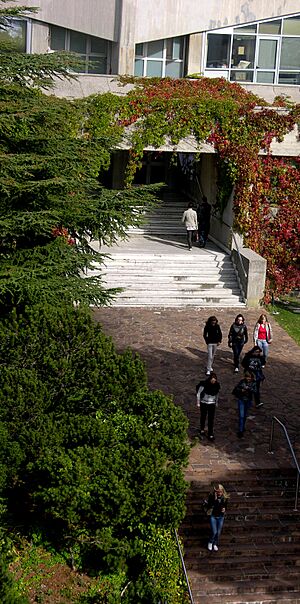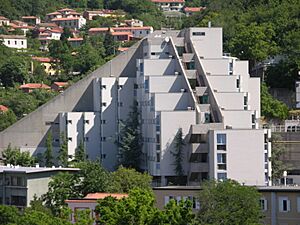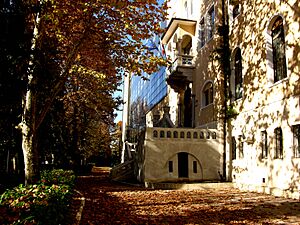University of Trieste facts for kids
|
Università degli Studi di Trieste
|
|
 |
|
| Latin: Universitas Studiorum Tergestum | |
| Type | Public |
|---|---|
| Established | 1924 |
| Rector | Prof. Roberto Di Lenarda |
|
Administrative staff
|
1,000 |
| Students | 15,177 |
| Location |
,
Italy
|
| Campus | Urban |
| Sports teams | CUS Trieste |
| Affiliations | Almalaurea, CEI University Network, Nettuno (accessed 26 February 2014) |
| Website | www.units.it |
The University of Trieste (in Italian: Università degli Studi di Trieste, or UniTS) is a public university in the city of Trieste, Italy. A public university is funded by the government, making it open to everyone. It is a research university, which means its professors and students work on discovering new things.
The university has 10 different departments, offering a wide variety of subjects to study. About 15,000 students attend the university, and they are taught by around 1,000 professors. It was officially founded in 1924.
Trieste is a city known for science, and the university works closely with many other research centers in the area. This network of science organizations is sometimes called the "Trieste System." This teamwork helps make Trieste an important hub for scientific discovery.
Contents
History of the University
Long before the university existed, Trieste was part of the Austro-Hungarian Empire. The Italian-speaking people in the city wanted their own university, but the government at the time said no.
After World War I, Trieste became part of Italy. A local business school was upgraded, and in 1924, it officially became the University of Trieste. At first, it focused on subjects like economics and business.
In 1938, a law department was added, and the university was given the grand title of Regia Università degli Studi (The Royal University of Studies). That same year, construction started on a new main building on a hill overlooking the city.
World War II slowed down the university's growth. A new engineering department was started in 1942, but it could only teach about ship engineering during the war. After the war, Trieste was temporarily managed by the United Kingdom and the United States of America. During this time, new departments for literature, philosophy, and sciences were added.
In 1954, Trieste was officially returned to Italy. To celebrate, the university gave an honorary degree to the President of Italy, Luigi Einaudi. After that, the university grew quickly, adding more departments like Pharmacy, Medicine, and Political Science. Over the years, it also added schools for languages, psychology, and architecture.
How the University is Organized
The University of Trieste is divided into 10 main departments. Think of these like different schools within the university, each focused on a specific area of study.
- Department of Medical, Surgical and Health Sciences
- Department of Physics
- Department of Engineering and Architecture
- Department of Mathematics and Geosciences (the study of the Earth)
- Department of Chemical and Pharmaceutical Sciences
- Department of Life Sciences (like biology)
- Department of Economics, Business, Mathematical and Statistical Sciences
- Department of Legal, Language, Interpreting and Translation Studies
- Department of Political and Social Sciences
- Department of Humanities (subjects like history, literature, and philosophy)
The university also has a Language Centre. This center helps students learn new languages and offers Italian courses for international students who come to study in Trieste.
Campus Buildings and Locations
The university's buildings are spread out across Trieste and even in other nearby cities.
Main Campus
The main campus is on a hill called Scoglietto. The central building here contains the main offices, the main library, and the departments of Law and Political Science. Other buildings on this campus are home to departments like Economics, Pharmacy, Science, and Engineering. There are also student dorms and a cafeteria on the main campus.
Other Locations in Trieste
- The departments that study the Earth (Geological and Earth Sciences) are located in a park not far from the main campus.
- The Humanities department is in the city center, near the sea.
- The school for interpreters and translators is located in a historic building called the Narodni Dom.
- The Faculty of Medicine and Surgery is located in buildings connected to the city's three main hospitals.
- The Physics and Astronomy departments have buildings located near the International Centre for Theoretical Physics and the city's two observatories.
Campuses in Other Cities
The University of Trieste also has smaller campuses, called satellite sites, in other cities:
- Pordenone: This campus offers courses in Engineering and Education.
- Gorizia: Here, students can study international relations and business.
- Portogruaro: This campus, located in the nearby Veneto region, has an Education department.
The Trieste System: A City of Science
Trieste is known as a major center for science and research. The University of Trieste is a key part of a network of scientific organizations called the "Trieste System." This means the university works with many other top-level research institutes located in the city.
Some of the important partners include:
- Abdus Salam International Centre for Theoretical Physics (ICTP): A world-famous center for physics research.
- International School for Advanced Studies (SISSA): A top school for graduate students in science.
- International Centre for Genetic Engineering and Biotechnology (ICGEB): Focuses on biology and medicine.
- Elettra Sincrotrone Trieste: A facility that uses powerful light to study materials at a tiny scale.
- Trieste Observatory: An astronomical observatory for studying stars and galaxies.
This close cooperation makes Trieste a very exciting place for students and scientists from all over the world.
Interesting Places on Campus
- Orto Botanico dell'Università di Trieste: This is the university's botanical garden. It was started in 1963 and is used for teaching and research about plants.
- Radioincorso.it: The university has its own web radio station, run by students.
Notable People
Many famous and successful people have studied or taught at the University of Trieste.
Famous Teachers
- Margherita Hack: A world-renowned astrophysicist who studied stars.
- Claudio Magris: A famous writer and expert on German literature.
- Gillo Dorfles: An important art critic and philosopher.
- Gaetano Kanizsa: A psychologist known for his work on how our brains see things, including optical illusions.
Famous Graduates
- Roberto Fico: A politician who served as the President of the Italian Chamber of Deputies, one of the two houses of the Italian Parliament.
- Andrea Illy: A successful businessman and the chairman of the famous coffee company, Illy.
- Lamberto Zannier: A diplomat who has held important roles in international organizations working for peace and security.
- Dario Floreano: A scientist who designs robots inspired by nature.
See also
 In Spanish: Universidad de Trieste para niños
In Spanish: Universidad de Trieste para niños
- List of Italian universities
- List of modern universities in Europe (1801–1945)
- International School for Advanced Studies
Images for kids


